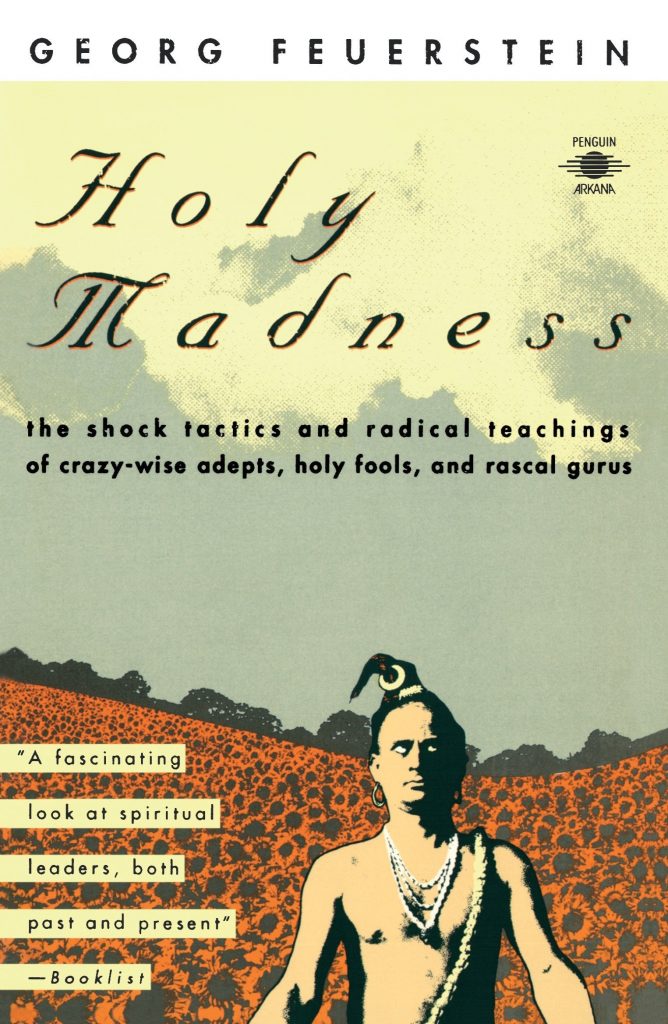Holy Madness: The Shock Tactics and Radical Teachings of Crazy-Wise Adepts, Holy Fools, and Rascal Gurus
By Georg Feuerstein.
Paragon House: New York, 1991.
259 pp. $24.95 (hardcover).
Everyone is entitled to receive at least two pearls of wisdom in exchange for the four years of often misdirected efforts known as “college.” For me they came in two successive sentences of Professor Irving Halperin’s lecture on twentieth-century literature: “A paragraph should always be slightly longer than it is wide…And never read anything but great books—and truly awful books.”
Of course the vast majority of books falls in between these two extremes, and that includes Georg Feuerstein’s Holy Madness. The text is intended to be a study of holy madness: an important phenomenon in religious traditions that has “so far not been recognized as a universal category of religious life.” What Feuerstein means by “holy madness” (or “crazy wisdom,” as he more frequently refers to the phenomenon) is a “radical” style of religious teaching which is designed to shock the conventional mind and at the same time to communicate an “alternative vision to that which governs ordinary life.” According to Feuerstein, the tactics of “crazy wisdom” include the use of alcohol, drugs, and sex: “[The] adepts of holy madness do not mind either filth or excessive luxury. Their generally outrageous behavior does not at all conform to our cherished ideas of religiosity, morality, and sanctity.”
Feuerstein first defines the phenomena of holy madness by way of example, attempting to sketch the cross-cultural and historical dimensions (referring to tricksters, clowns, “Fools for Christ’s Sake,” Sufis, Bauls in India, Tantric adepts of Tibet, and Zen masters). This general discussion is fleshed out, so to speak, by brief accounts of contemporary “crazy-wisdom adepts:” Gurdjieff, Aleister Crowley, Rajneesh, Chogyam Trungpa, Lee Lozowick, and and Da Love-Ananda (a.k.a. Da Free John). Although these accounts are touted as “detailed profiles” on the book’s dust jacket, the portraits are disappointingly superficial, sensationalist, and journalistic without being investigative. With the exception of Da Love-Ananda (avowed avatar and Feuerstein’s own crazy wisdom teacher), each of the subjects is covered in no more than six pages.
If we take Feuerstein’s reflections on Gurdjieff as an example of the book’s accuracy, objectivity, and depth of research, then serious doubts arise. The first two pages on Gurdjieff are meant, one supposes, to be a simple retelling of events that place him in a historical context. One would expect this part of the study to provide little difficulty, particularly with regard to the accuracy of dates. If we forgive the author’s inaccurate date of birth for Gurdjieff (“perhaps in 1877”) as the repetition of a problem familiar to other writers on Gurdjieff, it is not so easy to overlook his more blatant errors of fact. For example, Gurdjieff did not return to Russia in 1914, as suggested by Mr. Feuerstein, but in 1912; the New Zealand writer Katherine Mansfield died of pulmonary tuberculosis on January 12, 1923, not 1924; Gurdjieff’s famous motor accident was not in 1934, but in 1924.
Of course dates are not the real issue here, but frequent errors of fact tend to shake a reader’s confidence. More disturbing are the author’s gratuitous conclusions, for example the claim that Gurdjieff’s teaching contained “very little compassion or love.”
The sequence of profiles is curious: Gurdjieff is followed by Aleister Crowley. The author’s emphasis on Crowley’s sexual eccentricities, his “self-delusion,” and heroin addiction are apparently meant to establish a case of “crazy wisdom gone awry,” to present an example of an “individual who succeeds in unlocking the gates to the hidden dimension of existence without first having become grounded in… love and compassion.” It seems quite plausible that Crowley was indeed crazy, particularly later in life, but was he ever really wise? Feuerstein justifies his inclusion of Crowley by suggesting that his bizarre life is useful as a yardstick to “measure relative success or failure of other crazy-wise adepts.” But why Crowley’s debauched and desperate life should stand as a yardstick for others is an unelaborated mystery.
Throughout these profiles sex is the tail that wags the dog. Feuerstein is content to rehash stories and “rumors” of sexual indiscretion, promiscuity, and perversion that have been exploited ad nauseam. Sex may sell books, but there is another dimension to the question of sex and spiritual guidance in America today which relates to many of the themes raised in Holy Madness.
Our culture’s attitude toward spiritual guides might be seen as similar to an adolescent’s approach to sex—simultaneous fascination and terror. Fascination because the men and women who offer guidance embody an ideal of spiritual growth and transformation, and terror because when we come into contact with them our individuality and independence are suddenly in question. Holy Madness seems to offer more in the way of alternating images of fascination and terror than new material for an evolved, substantial study of spiritual guidance in the West.
Feuerstein reaches the conclusion that “our age will develop its own characteristic spirituality and that this will give rise to a new class of spiritual guides.” His point is well taken, but it will be a long process of trial and error if we do not learn how to bring more of ourselves to the question.
Holy Madness raises several issues that need to be studied. And while Feuerstein puts his own spin on these issues, they have all been raised before and with more insight. To raise the study of crazy wisdom up to a new level, fresh ideas must be introduced and new questions asked—not because we have tired of answers already given, but because we have arrived at a more serious approach to our questions.
Thank you for subscribing to Tricycle! As a nonprofit, we depend on readers like you to keep Buddhist teachings and practices widely available.
